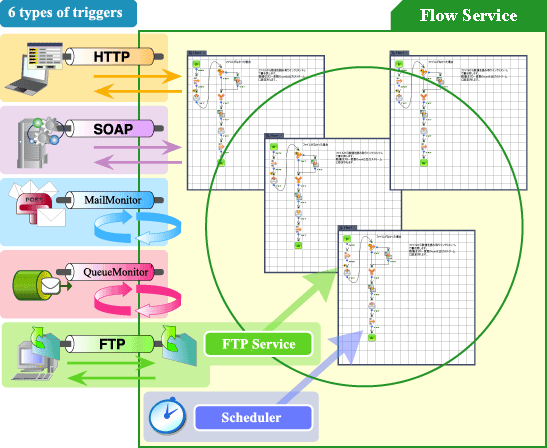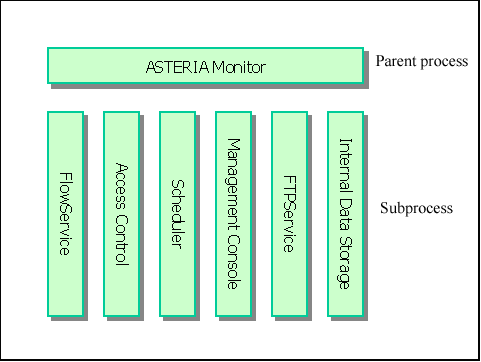Here is the introduction for the whole Flow Service.
What’s Flow Service?
Flow Service is a platform where a processing of an information system is shown as an icon. By connecting icons according to a processing procedure, you can control and execute a Flow which records the whole processing. A processing location is called component, the place where the processing is recorded is called Flow. By connecting Flow Designer where a Flow is designed to Flow Service where a Flow runs, then creating a Flow and saving it into the server,you can execute the Flow by trigger. For example, once you input an HTML file and send it, the HTTP server where Flow Service is built will receive the HTTP request, then Flow Service will execute the Flow connected to a URL, at last, the input data will be processed by kinds of components and output into the database.
The Flow Service has prepared daily processings with component. The interfaces built in some components support Internet protocols and applications which is needed to connect systems inside and outside an enterprise, and some components are used to input and output kinds of datas, such as CSV, XML, Excel. By connecting icons with lines, the whole system can be understood easily, so that the communication gaps between the members in one system development team will disappear. As a result, you can handle with the problems in a system flexibly, such as add or change. Moreover, by collecting up processings with component, you can use them repeatedly without coding every time, so that you can spend less time and money on developing a system.
There are 6 kinds of triggers for running a Flow as below. Moreover, we also have prepared some commands for running a Flow.
| Execution methods | Flow Service | Triggers |
|---|---|---|
| Run by HTTP | Make a connection between a Flow and a URL | Send an HTTP request from any client to run a Flow. |
| Run by SOAP | Make a connection between a Flow and a method name | Send a request from any SOAP client to run a Flow. |
| Run by FTP | Monitor a folder with an FTP service in which the Flow Service is built. | Forward a file by FTP from an external system to run a Flow |
| Run by mail | Monitor a mail server regularly | Send a mail from any mail client to run a Flow |
| Run by message queue | Monitor a message queue regularly | Send a message from any client to run a Flow |
| Run by schedule | Control with a scheduler in which the Flow Service is built | Run a Flow by any time, date or interval |
Triggers for running Flow
Flow Products
Flow function consists of the Flow Designer which is an integrated design environment based on GUI and the Flow Service which is its execution environment. Moreover, the web-based “Flow Service Management Console” function is built in the Flow Service for setting and maintainence.
Flow Designer It’s an integrated development environment based on GUI.
Flow Service It’s a server environment for running services related to Flow.
Flow Service Management Console It’s a management tool for the Flow Service settings.
Flow Designer
Flow Designer is an integrated development environment, which represents a series of processings graphcally, such as data extraction, transmission or distribution by creating, saving and running a Flow. The most basic operation is to create a Flow by Flow Designer, then log into the Flow Service, and at last run the Flow there. There are kinds of icons representing daily functions in the Flow Designer, for example, the icon for sending request to HTTP server, the icon for getting data from RDB, the icon for converting data. You can program easily by dragging icons into workspace, and connecting them with lines.
The Flow Designer contains the below tools.
Trigger management The tool has monitoring function. Having been connected, the tool can monitor “Execution settings” for defining Flow and execution method, and the execution status of a Flow.
Log viewer Having been connected, the tool can display logs output by the Flow Service.
Diff tool By comparing with 2 projects or function collections, the tool will display the modification graphically.
Create table definition document By connecting to database, the tool will output the table definition into a specification document.
WebMacro recorder The tool records the data input for URL and FORM in Web browser by user.
Flow Service
The Flow Service is a platform for running a created Flow. You can register a Flow created by Flow Designer into the Flow Service and save it, then run the Flow by external trigger or schedule. In the Flow Service, running a Flow by multithreading is most effective.
Management Console
Flow Service Management Console is a tool for setting and maintaining by Web browser. You can create your Flow Service account, or check logs, or start/stop process here.
Function list
Flow Service Management Console’s functions are as below.
|_. Functions Descriptions
“Status” tab It contains tabs for checking and managing the Flow Service and the execution status of Flows.
Log It’s used to refer to application logs which output information set by users with Flow service or Flow.
Flow It’s used to check the status of a Flow or run a Flow.
DeploymentSettings It’s used to refer to, register, change, delete an execution settings of a Flow.
Version control By using the version management, you can check the current version and revision history or update to any version.
“Settings” tab It’s used to set Flow Service communication.
Connection It’s used to set connections such as RDB and Internet protocols.
Proxy The setting is used when send HTTP, HTTPS request from Flow Service via proxy.
SSL The certification for SSL communication is stored here.
Log You can modify log settings of Flow Service. You can also create or modify log settings for outputing from a Flow.
Notification The setting is for notifying the admin by mail when any error happens in the server.
Service Kinds of settings for Flow Service can be done here.
Password You can change a password here for the user who wants to log into the Management Console.
“Tools” tab The setting is for the tools used in the Flow Service.
Account Flow Service account is managed here.
Maintenance You can maintain or restore the logs output by the Flow Service, and create backup for them.
Calendar Set or display holidays of the system calendar for schedule function.
Service You can check, run or stop the state for the services running in Flow Service.
“Help” tab Here provides kinds of information and help links.
Server information Here provides the information of the server and OS, Java.
Licence information Here provides the licence of our product.
Help links Here are the links for kinds of Helps.
Flow Service’s Specification
Supported Formats
XML / HTML / CSV / Fixed length / Text / Binary / ZIP / PDF / Excel (*1)/ XBRL (*1)
*1:Optional product
Supported Databases
- Oracle
- IBM DB2
- IBM AS/400 iSeries DB2
- Microsoft SQL Server/SQL Azure
- Microsoft Access
- PostgreSQL
- MySQL
- MariaDB
- Netezza
- Dr.SumEA
- FileMaker
*About the supported versions, please refer to the product homepage.
Supported Network Protocols
- HTTP / HTTPS
- SMTP / SMTPS
- POP3 / POP3S
- IMAP / IMAPS
- FTP / SFTP
- LDAP
- SOAP 1.1
- Supported Applications
- IBM Lotus Notes/Domino
- NeoCoreXMS
- Microsoft Excel
- Microsoft Active Directory
*About the supported versions, please refer to the product homepage.
the Flow Service’s Process Structure
Inside the Flow Service, where you can run a Flow, there are multiple services. In these services, the one which has an engine for running a Flow and manages the execution is called Flow Service. In this part, the whole execution environment, Flow Service, is considered as a “server”.
Each service is stored as a process in the memory, and each process has a seperate Java VM (Java Virtual Machine)instance. Moreover, each service can process multiple requests at the sametime by multithreading.
In these services, ASTERIA Monitor is a super process, which runs or stops the other services as subprocesses, and monitors their execution statuses.
Server (the whole Flow Service) structure image
Service name list
In a standuard structure, the services as below are registered.
| Service names | Descriptions |
|---|---|
| FlowService | The service has an engine used to run Flow and an HTTP listener. |
| AccessControl | The service manages and authenticates the Flow Service account. |
| Scheduler | By registering a specified date and time or a start date and a repeat interval, the service will run the specified Flow once the time comes. |
| ManagementConsole | The service can set and maintain the “Server” by Web browser. |
| FtpService | It’s an FTP server installed standurdly in the “Server”. It can run a Flow once a file is received. (In the default setting, it’s set not to run.) |
| InternalDataStorage | The database is used when the “server” stores internal data. Because it’s for BtoB only, the data for other usual purposes won’t increase. Moreover, inside the service, “HSQL (http://hsqldb.sourceforge.net/)“is applied. |
FlowService’s structure
As the “server”‘s core, FlowService consists of kinds of listeners and a Flow Engine. The listeners are used to receive external events, and the Flow engine is used to run Flow.
After reading project files (the extension is “.xfp”) dynamically, which are XML files used to record Flow’s processing procedure, Flow Engine compiles the files and saves them. Then it runs the Flow specified by trigger, listerner, by multithreading.
Inside a Flow, components works in cooperation. Some communications with FTP server or database server outside the “server” use connection. Because a pool of connections can be made, we can cost less when initialize.
The concept image is as below. For more information about each concept, please refer to “Flow Service’s architecture”-“Flow Service’s execution model” under “More topics” in the left side menu.
FlowSerive’s concept image
Cooperation between the Flow Service and the other services
The Flow Service works in cooperation with the other services, such as Scheduler and AccessControl. The operation model is as below.
Operation model image
Flow Service’s File Structure
The files of the Flow Serive are put in 2 places as below. We will instrcut about these folders by using “folder notation”.
Target Folder notation Default path
Flow Service
Installation folder [INSTALL_DIR] Windows C:\Program Files\asteriawarp
UNIX /[Installtion user’s home directory]/asteriawarp
Data folder [DATA_DIR] Windows C:\asteriahome
UNIX /[Installtion user’s home directory]/asteriahome
Installation folder’s structure
The folerd with (*) will be used when a user configures or refers to files for applying or developing. For more information about the files used for maintenance or migration, please refer to “Administration”-“Maintainence”, “Backup”
| Folder | Description |
|---|---|
| [INSTALL_DIR]/common | Libraries shared with other services |
| [INSTALL_DIR]/license (*) | Licence files |
| [INSTALL_DIR]/jre/lib/ext (*) | Drivers, such as JDBC |
| [INSTALL_DIR]/flow/bin (*) | Execution files |
| [INSTALL_DIR]/flow/conf | Setting files |
| [INSTALL_DIR]/flow/data | InternalDataStorage data, such as SSL and KeyStore |
| [INSTALL_DIR]/flow/lib | Libraries |
| [INSTALL_DIR]/flow/lib/flowlib | Libraries about components and mapper functions |
| [INSTALL_DIR]/flow/log (*) | Log files that can be referred to with the Management Console and the log viewer 注:管理コンソールから出力先を変更することができます。 |
| [INSTALL_DIR]/flow/services | Original definition files of service |
| [INSTALL_DIR]/flow/services/flowservice/conf | Flow Service’s setting files |
| [INSTALL_DIR]/flow/webapps | Files related to the Flow Service Management Console |
← Getting Started:”(topic-link-next)Flow Service Components →”:https://www.manula.com/manuals/infoteria-corporation/asteria-warp/4.8.1/zc/topic/flow-service-components





Post your comment on this topic.